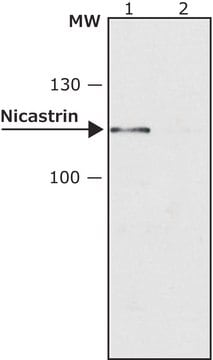MAB1563
Anti-Presenilin-1 Antibody, NT, clone hPS1-NT
culture supernatant, clone hPS1-NT, Chemicon®
Sinônimo(s):
Anti-ACNINV3, Anti-FAD, Anti-PS-1, Anti-PS1, Anti-S182
About This Item
Produtos recomendados
fonte biológica
rat
Nível de qualidade
forma do anticorpo
culture supernatant
tipo de produto de anticorpo
primary antibodies
clone
hPS1-NT, monoclonal
reatividade de espécies
human
fabricante/nome comercial
Chemicon®
técnica(s)
ELISA: suitable
immunohistochemistry: suitable
immunoprecipitation (IP): suitable
western blot: suitable
Isotipo
IgG2a
nº de adesão NCBI
nº de adesão UniProt
Condições de expedição
wet ice
modificação pós-traducional do alvo
unmodified
Informações sobre genes
human ... PSEN1(5663)
Especificidade
Imunogênio
Aplicação
Immunoblotting: 1:250-1:500. Recommend blocking buffer is TBS containing 5% non fat milk and 0.01% Tween 20. It is recommended that you also dilute the antibody in this blocking buffer. Incubate with the MAB1563 for 1 to 2 hours at room temperature or overnight at 4°C.
Immunoprecipitation
ELISA
Optimal working dilutions must be determined by end user.
Neuroscience
Neurodegenerative Diseases
Descrição-alvo
forma física
Armazenamento e estabilidade
Nota de análise
Brain tissue
Outras notas
Informações legais
Exoneração de responsabilidade
Not finding the right product?
Try our Ferramenta de seleção de produtos.
recomendado
Código de classe de armazenamento
10 - Combustible liquids
Classe de risco de água (WGK)
WGK 1
Ponto de fulgor (°F)
Not applicable
Ponto de fulgor (°C)
Not applicable
Certificados de análise (COA)
Busque Certificados de análise (COA) digitando o Número do Lote do produto. Os números de lote e remessa podem ser encontrados no rótulo de um produto após a palavra “Lot” ou “Batch”.
Já possui este produto?
Encontre a documentação dos produtos que você adquiriu recentemente na biblioteca de documentos.
Nossa equipe de cientistas tem experiência em todas as áreas de pesquisa, incluindo Life Sciences, ciência de materiais, síntese química, cromatografia, química analítica e muitas outras.
Entre em contato com a assistência técnica





